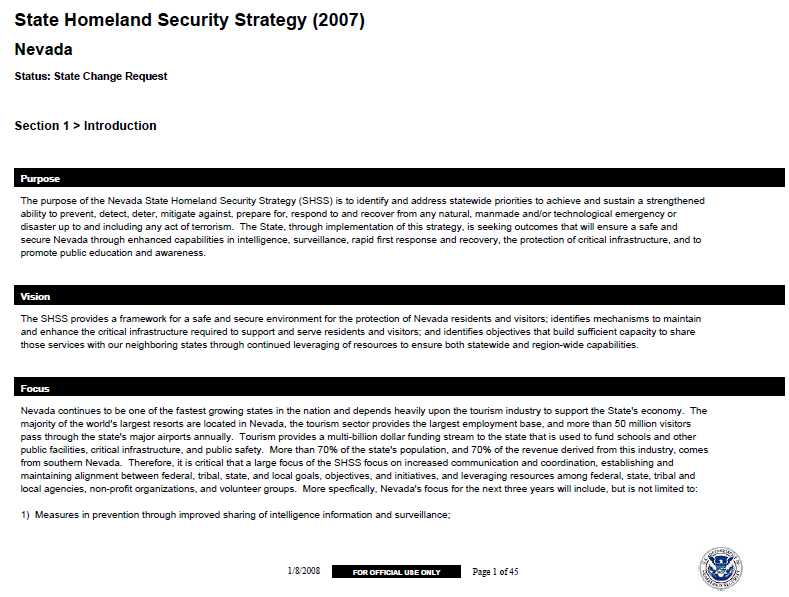 State Homeland Security Strategy (2007)
State Homeland Security Strategy (2007)
- 45 pages
- For Official Use Only
- January 8, 2008
The purpose of the Nevada State Homeland Security Strategy (SHSS) is to identify and address statewide priorities to achieve and sustain a strengthened ability to prevent, detect, deter, mitigate against, prepare for, respond to and recover from any natural, manmade and/or technological emergency or disaster up to and including any act of terrorism. The State, through implementation of this strategy, is seeking outcomes that will ensure a safe and secure Nevada through enhanced capabilities in intelligence, surveillance, rapid first response and recovery, the protection of critical infrastructure, and to promote public education and awareness.
…
Focus
Nevada continues to be one of the fastest growing states in the nation and depends heavily upon the tourism industry to support the State’s economy. The majority of the world’s largest resorts are located in Nevada, the tourism sector provides the largest employment base, and more than 50 million visitors pass through the state’s major airports annually. Tourism provides a multi-billion dollar funding stream to the state that is used to fund schools and other public facilities, critical infrastructure, and public safety. More than 70% of the state’s population, and 70% of the revenue derived from this industry, comes
from southern Nevada. Therefore, it is critical that a large focus of the SHSS focus on increased communication and coordination, establishing and maintaining alignment between federal, tribal, state, and local goals, objectives, and initiatives, and leveraging resources among federal, state, tribal and local agencies, non-profit organizations, and volunteer groups. More specfically, Nevada’s focus for the next three years will include, but is not limited to:1) Measures in prevention through improved sharing of intelligence information and surveillance;
2) Communications Interoperability;
3) Development, review, and/or update of state and local emergency operations plans, continuity of government plans and terrorism prevention and
detection plans while ensuring complete implementation of the National Incident Management System;
4) Development, review, and/or update of statewide interstate and intrastate mutual aid compacts, regional plans and regional collaboration;
5) Continued equipping and training of Nevada’s emergency first responders and support agencies;
6) Establishing/enhancing agro-terrorism preparedness capabilities;
7) Improving Nevada’s capabilities to detect, identify, and report radiological and nuclear materials present in unauthorized locations;
8) Public education and awareness programs;
9) Enhancing measures to secure and harden critical infrastructure sites;
10) Development and implementation of systems to secure and coordinate transportation resources;
11) Development, review, update and/or finalization of medical facility emergency care plans, and medical surge and mass prophylaxis capabilities;
12) Establish programs to serve special needs populations; and
13) To create an awareness of the legal issues that surround emergency management, emergency response and homeland security activities.
Through these initiatives, Nevada will continue to build and enhance a comprehensive and coordinated statewide and regional partnership of all agencies,
preparing them to adequately respond to any type of emergency or disaster.

